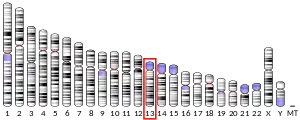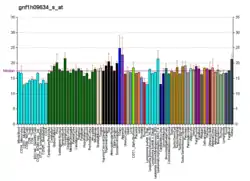| GPC5 | |||||||||||||||||||||||||||||||||||||||||||||||||||
|---|---|---|---|---|---|---|---|---|---|---|---|---|---|---|---|---|---|---|---|---|---|---|---|---|---|---|---|---|---|---|---|---|---|---|---|---|---|---|---|---|---|---|---|---|---|---|---|---|---|---|---|
| Identifiers | |||||||||||||||||||||||||||||||||||||||||||||||||||
| Aliases | GPC5, glypican 5 | ||||||||||||||||||||||||||||||||||||||||||||||||||
| External IDs | OMIM: 602446 MGI: 1194894 HomoloGene: 3285 GeneCards: GPC5 | ||||||||||||||||||||||||||||||||||||||||||||||||||
| |||||||||||||||||||||||||||||||||||||||||||||||||||
| |||||||||||||||||||||||||||||||||||||||||||||||||||
| |||||||||||||||||||||||||||||||||||||||||||||||||||
| |||||||||||||||||||||||||||||||||||||||||||||||||||
| |||||||||||||||||||||||||||||||||||||||||||||||||||
| Wikidata | |||||||||||||||||||||||||||||||||||||||||||||||||||
| |||||||||||||||||||||||||||||||||||||||||||||||||||
Glypican-5 is a protein that in humans is encoded by the GPC5 gene.[5][6]
Cell surface heparan sulfate proteoglycans are composed of a membrane-associated protein core substituted with a variable number of heparan sulfate chains. Members of the glypican-related integral membrane proteoglycan family (GRIPS) contain a core protein anchored to the cytoplasmic membrane via a glycosyl phosphatidylinositol linkage. These proteins may play a role in the control of cell division and growth regulation.[6]
See also
References
- 1 2 3 GRCh38: Ensembl release 89: ENSG00000179399 - Ensembl, May 2017
- 1 2 3 GRCm38: Ensembl release 89: ENSMUSG00000022112 - Ensembl, May 2017
- ↑ "Human PubMed Reference:". National Center for Biotechnology Information, U.S. National Library of Medicine.
- ↑ "Mouse PubMed Reference:". National Center for Biotechnology Information, U.S. National Library of Medicine.
- ↑ Veugelers M, Vermeesch J, Reekmans G, Steinfeld R, Marynen P, David G (Jun 1997). "Characterization of glypican-5 and chromosomal localization of human GPC5, a new member of the glypican gene family". Genomics. 40 (1): 24–30. doi:10.1006/geno.1996.4518. PMID 9070915.
- 1 2 "Entrez Gene: GPC5 glypican 5".
Further reading
- De Cat B, David G (2001). "Developmental roles of the glypicans". Semin. Cell Dev. Biol. 12 (2): 117–25. doi:10.1006/scdb.2000.0240. PMID 11292377.
- Watanabe K, Yamada H, Yamaguchi Y (1995). "K-glypican: a novel GPI-anchored heparan sulfate proteoglycan that is highly expressed in developing brain and kidney". J. Cell Biol. 130 (5): 1207–18. doi:10.1083/jcb.130.5.1207. PMC 2120559. PMID 7657705.
- Saunders S, Paine-Saunders S, Lander AD (1997). "Expression of the cell surface proteoglycan glypican-5 is developmentally regulated in kidney, limb, and brain" (PDF). Dev. Biol. 190 (1): 78–93. doi:10.1006/dbio.1997.8690. PMID 9331333. S2CID 25320509.
- Veugelers M, De Cat B, Delande N, et al. (2002). "A 4-Mb BAC/PAC contig and complete genomic structure of the GPC5/GPC6 gene cluster on chromosome 13q32". Matrix Biol. 20 (5–6): 375–85. doi:10.1016/S0945-053X(01)00143-3. PMID 11566272.
- Strausberg RL, Feingold EA, Grouse LH, et al. (2003). "Generation and initial analysis of more than 15,000 full-length human and mouse cDNA sequences". Proc. Natl. Acad. Sci. U.S.A. 99 (26): 16899–903. Bibcode:2002PNAS...9916899M. doi:10.1073/pnas.242603899. PMC 139241. PMID 12477932.
- Yu W, Inoue J, Imoto I, et al. (2004). "GPC5 is a possible target for the 13q31-q32 amplification detected in lymphoma cell lines". J. Hum. Genet. 48 (6): 331–5. doi:10.1007/s10038-003-0026-2. PMID 12721791.
- Dunham A, Matthews LH, Burton J, et al. (2004). "The DNA sequence and analysis of human chromosome 13". Nature. 428 (6982): 522–8. Bibcode:2004Natur.428..522D. doi:10.1038/nature02379. PMC 2665288. PMID 15057823.
- Gerhard DS, Wagner L, Feingold EA, et al. (2004). "The status, quality, and expansion of the NIH full-length cDNA project: the Mammalian Gene Collection (MGC)". Genome Res. 14 (10B): 2121–7. doi:10.1101/gr.2596504. PMC 528928. PMID 15489334.
This article is issued from Wikipedia. The text is licensed under Creative Commons - Attribution - Sharealike. Additional terms may apply for the media files.




